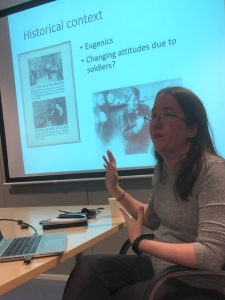Historical and Social Context

Disability researchers and activists often emphasize the importance of the social model of disability and similar perspectives. This model recognizes the role of barriers, including social attitudes, that contribute to the disablement process. A person might encounter more or fewer barriers in different contexts or over time.
In my project, I also apply the concept of syndemics, which shares similar themes with the social model of disability. A syndemic is characterized by two or more interacting health conditions that are influenced or worsened by social inequalities and environments.
Because my project considers a historical epidemic, I must also think about how attitudes about and understanding of both disability and infectious disease have developed over time. Two important considerations around the time of the 1918 flu are the eugenics movement and World War I.
In this picture, I am describing these considerations during a recent talk at OsloMet for people interested in Norwegian demography. We discussed whether it is appropriate or even possible to separate the “biological” and “social” factors that might produce health disparities for people with disabilities, and how historical analyses can be applied to present-day concerns. These questions are important and I welcome your own thoughts on them!